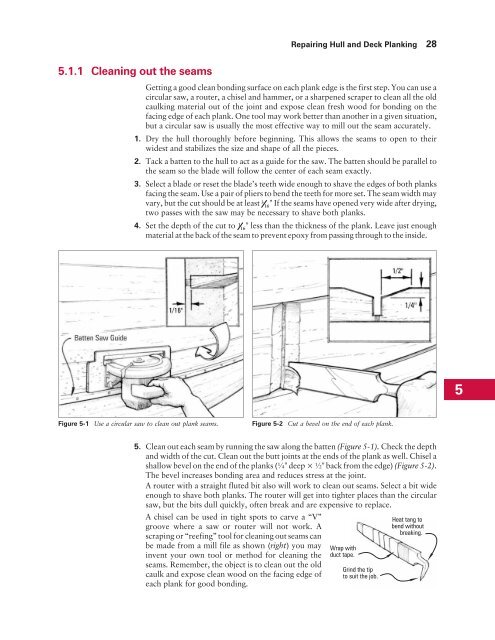Wooden Boat Restoration Repair - WEST SYSTEM Epoxy
Wooden Boat Restoration Repair - WEST SYSTEM Epoxy
Wooden Boat Restoration Repair - WEST SYSTEM Epoxy
Create successful ePaper yourself
Turn your PDF publications into a flip-book with our unique Google optimized e-Paper software.
5.1.1 Cleaning out the seams<br />
Getting a good clean bonding surface on each plank edge is the first step. You can use a<br />
circular saw, a router, a chisel and hammer, or a sharpened scraper to clean all the old<br />
caulking material out of the joint and expose clean fresh wood for bonding on the<br />
facing edge of each plank. One tool may work better than another in a given situation,<br />
but a circular saw is usually the most effective way to mill out the seam accurately.<br />
1. Dry the hull thoroughly before beginning. This allows the seams to open to their<br />
widest and stabilizes the size and shape of all the pieces.<br />
2. Tack a batten to the hull to act as a guide for the saw. The batten should be parallel to<br />
the seam so the blade will follow the center of each seam exactly.<br />
3. Select a blade or reset the blade’s teeth wide enough to shave the edges of both planks<br />
facing the seam. Use a pair of pliers to bend the teeth for more set. The seam width may<br />
vary, but the cut should be at least 3 16" If the seams have opened very wide after drying,<br />
two passes with the saw may be necessary to shave both planks.<br />
4. Set the depth of the cut to 1 16" less than the thickness of the plank. Leave just enough<br />
material at the back of the seam to prevent epoxy from passing through to the inside.<br />
5. Clean out each seam by running the saw along the batten (Figure 5-1). Check the depth<br />
and width of the cut. Clean out the butt joints at the ends of the plank as well. Chisel a<br />
shallow bevel on the end of the planks (¼" deep × ½" back from the edge) (Figure 5-2).<br />
The bevel increases bonding area and reduces stress at the joint.<br />
A router with a straight fluted bit also will work to clean out seams. Select a bit wide<br />
enough to shave both planks. The router will get into tighter places than the circular<br />
saw, but the bits dull quickly, often break and are expensive to replace.<br />
A chisel can be used in tight spots to carve a “V”<br />
groove where a saw or router will not work. A<br />
scraping or “reefing” tool for cleaning out seams can<br />
be made from a mill file as shown (right) you may<br />
invent your own tool or method for cleaning the<br />
seams. Remember, the object is to clean out the old<br />
caulk and expose clean wood on the facing edge of<br />
each plank for good bonding.<br />
<strong>Repair</strong>ing Hull and Deck Planking 28<br />
Figure 5-1 Use a circular saw to clean out plank seams. Figure 5-2 Cut a bevel on the end of each plank.<br />
Wrap with<br />
duct tape.<br />
Grind the tip<br />
to suit the job.<br />
Heat tang to<br />
bend without<br />
breaking.<br />
5
















